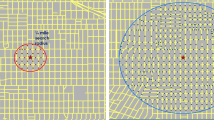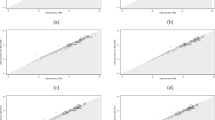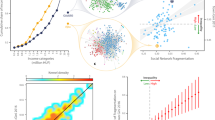Abstract
Patterns of street connectivity and poverty in the US and Mexico are investigated by means of spatial analysis and statistical techniques. The evaluation is conducted at three levels of spatial aggregation: 389 (74) metropolitan areas, 3,106 (2,432) counties (municipalities), and 58,953 (27,413) census tracts of the US (Mexico). The article explores whether the physical configuration of the street network may affect geographical concentration of poverty. To quantitatively measure differences in network patterns, we consider six metrics: street density, intersection density, regularity, betweenness, closeness and information centrality. The results reveal that relationships between connectivity and poverty have opposite signs in the two countries. For example, whereas intersection density and betweenness centrality positively influence the spatial agglomeration of low-income households in the US, the reverse pattern of association is observable in Mexico. Furthermore, differences in street layouts between low-income and high-income neighborhoods are more pronounced among Mexican cities.






Similar content being viewed by others
Notes
In the case of the US, we have removed tracts from Napa, CA metro area because they all exhibited a very low level of poverty [0–18%], thus no comparison among different groups of poverty levels is possible. As a robustness check, we also used the conventional definitions of poor neighborhoods: [0–10%], (10–20%], (20–30%], (30–40%], and (40–100%] as suggested by studies dealing with census tract and neighborhood data (Kneebone et al. 2011; Solari 2012). Results are consistent with those reported in the left panel of Fig. 5 and differences in the percentage of metro areas rejecting H0 were negligible.
References
Ahlfeldt GM, Pietrostefani E (2019) The economic effects of density: A synthesis. J Urban Econ 111:93–107
Batty M (2007) Cities and complexity: understanding cities with cellular automata, agent-based models, and fractals. The MIT Pres, Cambridge, MA, USA
Benita F (2019) A new measure of transport disadvantage for the developing world using free smartphone data. Soc Indic Res 145(1):415–435
Benita F, Piliouras G (2020) Location, location, usage: How different notions of centrality can predict land usage in Singapore. Physica A: Stat Mech Appl 540:123221
Boeing G (2020) A multi-scale analysis of 27,000 urban street networks: Every US city, town, urbanized area, and Zillow neighborhood. Environment and Planning b: Urban Analytics and City Science 47(4):590–608
Büttner B, Kinigadner J, Ji C, Wright B, Wulfhorst G (2018) The TUM accessibility atlas: Visualizing spatial and socioeconomic disparities in accessibility to support regional land-use and transport planning. Netw Spat Econ 18(2):385–414
Carpenter A, Peponis J (2010) Poverty and connectivity. The Journal of Space Syntax 1(1):108–120
Cervero R (2009) Transport infrastructure and global competitiveness: Balancing mobility and livability. Ann Am Acad Pol Soc Sci 626(1):210–225
Currie G, Richardson T, Smyth P, Vella-Brodrick D, Hine J, Lucas K, Stanley J, Kinnear R, Stanley J (2010) Investigating links between transport disadvantage, social exclusion and well-being in Melbourne-Updated results. Res Transp Econ 29(1):287–295
Duque JC, Lozano-Gracia N, Patino JE, Restrepo P, Velasquez WA (2019) Spatiotemporal dynamics of urban growth in Latin American cities: An analysis using nighttime light imagery. Landsc Urban Plan 191:103640
Ewing R, Schieber RA, Zegeer CV (2003) Urban sprawl as a risk factor in motor vehicle occupant and pedestrian fatalities. Am J Public Health 93(9):1541–1545
Garnica-Monroy R, Alvanides S (2019) Spatial segregation and urban form in Mexican cities. Environment and Planning b: Urban Analytics and City Science 46(7):1347–1361
Gonzalez-Navarro M, Quintana-Domeque C (2016) Paving streets for the poor: Experimental analysis of infrastructure effects. Rev Econ Stat 98(2):254–267
Guzman LA, Oviedo D, Rivera C (2017) Assessing equity in transport accessibility to work and study: The Bogotá region. J Transp Geogr 58:236–246
Haberman CP, Kelsay JD (2021) The Topography of Robbery: Does Slope Matter? J Quant Criminol 37:625–645
Hillier B, Hanson J (1989) The social logic of space. Cambridge University Press, Cambridge, MA, USA
Houston D, Wu J, Ong P, Winer A (2004) Structural disparities of urban traffic in Southern California: implications for vehicle-related air pollution exposure in minority and high-poverty neighborhoods. J Urban Aff 26(5):565–592
Jiang B, Claramunt C (2004) Topological analysis of urban street networks. Environ Plann B Plann Des 31(1):151–162
Kneebone E, Nadeau C, Berube A (2011) The re-emergence of concentrated poverty: Metropolitan Trends in the 2000s. The Brookings Institution Metropolitan Policy Program, Washington, DC
Lee BH, Jung WS (2018) Analysis on the urban street network of Korea: Connections between topology and metainformation. Physica A: Stat Mech Appl 497:15–25
Lee RE, Soltero EG, Jáuregui A, Mama SK, Barquera S, Jauregui E, Lopez J, Ortiz-Hernández L, Lévesque L (2016) Disentangling associations of neighborhood street scale elements with physical activity in Mexican school children. Environ Behav 48(1):150–171
Lu C, Liu Y (2016) Effects of China’s urban form on urban air quality. Urban Studies 53(12):2607–2623
Lucas K (2011) Making the connections between transport disadvantage and the social exclusion of low income populations in the Tshwane Region of South Africa. J Transp Geogr 19(6):1320–1334
Mao Y, Yin L, Zeng M, Ding J, Song Y (2021) Review of Empirical Studies on Relationship between Street Environment and Crime. J Plan Lit 36(2):187–202
Markley S (2018) Suburban gentrification? Examining the geographies of New Urbanism in Atlanta’s inner suburbs. Urban Geogr 39(4):606–630
McIntosh C, Alegría T, Ordóñez G, Zenteno R (2018) The neighborhood impacts of local infrastructure investment: Evidence from urban Mexico. Am Econ J Appl Econ 10(3):263–286
Meijers EJ, Burger MJ (2010) Spatial structure and productivity in US metropolitan areas. Environ Plan A 42(6):1383–1402
Méndez-Lemus Y, Vieyra A (2014) Tracing processes in poverty dynamics: a tale of peri-urban small-scale farmers in Mexico City. Urban Studies 51(10):2009–2035
Moeinaddini M, Asadi-Shekari Z, Shah MZ (2014) The relationship between urban street networks and the number of transport fatalities at the city level. Saf Sci 62:114–120
Monkkonen P, Montejano J, Guerra E, Caudillo C (2020) Compact cities and economic productivity in Mexico. Urban Studies 57(10):2080–2097
Porta S, Strano E, Iacoviello V, Messora R, Latora V, Cardillo A, Wang F, Scellato S (2009) Street centrality and densities of retail and services in Bologna, Italy. Environ Plann B Plann Des 36(3):450–465
Psarra S, Kickert C, Pluviano A (2013) Paradigm lost: Industrial and post-industrial Detroit–An analysis of the street network and its social and economic dimensions from 1796 to the present. Urban Design International 18(4):257–281
Rui Y, Ban Y (2014) Exploring the relationship between street centrality and land use in Stockholm. Int J Geogr Inf Sci 28(7):1425–1438
Sobstyl JM, Emig T, Qomi MA, Ulm FJ, Pellenq RM (2018) Role of city texture in urban heat islands at nighttime. Phys Rev Lett 120(10):108701
Solari CD (2012) Affluent neighborhood persistence and change in US cities. City Community 11(4):370–388
Srinivasan S (2002) Quantifying spatial characteristics of cities. Urban Studies 39(11):2005–2028
Thornton CM, Conway TL, Cain KL, Gavand KA, Saelens BE, Frank LD, Geremia C, Glanz K, King A, Sallis JF (2016) Disparities in pedestrian streetscape environments by income and race/ethnicity. SSM-Population Health 2:206–216
UN Habitat (2016) Measurement of city prosperity: methodology and metadata. United Nations Human Settlements Programme (UNHSP), Nairobi, Kenya
Wang F, Wen M, Xu Y (2013) Population-adjusted street connectivity, urbanicity and risk of obesity in the US. Appl Geogr 41:1–14
Winkelmann R (2008) Econometric analysis of count data. Springer Science & Business Media
Xiao Y, Orford S, Webster CJ (2016) Urban configuration, accessibility, and property prices: A case study of Cardiff, Wales. Environ Plann B Plann Des 43(1):108–129
Zuk M, Bierbaum AH, Chapple K, Gorska K, Loukaitou-Sideris A (2018) Gentrification, displacement, and the role of public investment. J Plan Lit 33(1):31–44
Acknowledgements
The research leading to these results is supported by funding from the Ministry of Education, Singapore, under its Grant SGPCTRS1804. The author is grateful to two anonymous reviewers for their wonderful insights.
Author information
Authors and Affiliations
Corresponding author
Ethics declarations
Conflict of Interests
The author declares that he has no known competing financial interests or personal relationships that could have appeared to influence the work reported in this paper.
Additional information
Publisher's Note
Springer Nature remains neutral with regard to jurisdictional claims in published maps and institutional affiliations.
Appendix
Appendix
In Table 2 we study regression models results using PM2.5 emissions, traffic fatalities and crimes as dependent variables. For ease of exposition, we examine only ordinary least squares (OLS) regressions including street network indicators and controls for socioeconomic characteristics. Our estimations yielded four findings. First, consistent with past research (Lu and Liu 2016; Sobstyl et al. 2018), one would expect to see a strong association between the network structure and air pollutant emissions. Estimated coefficients support this pattern for both countries. Second, aside from regularity, all network features identify channels through which the built-up environment may affect road traffic deaths in the US. This confirms the early evidence of Ewing et al. (2003), Houston et al. (2004) or Moeinaddini et al. (2014). Conversely, we did not find signs that the same holds true for Mexico. Third, in both countries under review, the composition of the street space structure influence criminal behavior, however, important variables differ among counties and municipalities. Fourth, the Pearson’s \(r\) correlations between poverty and the three secondary dependent variables show opposite directions in the two countries. For example, in the US, there is a presence of positive relationship (\(r=0.169\), p-value \(<0.01\)) between the percentage of the population living below the national poverty and reported offences per 1,000 people. At higher poverty levels, the reverse occurs in Mexico (\(r=-0.334\), p-value \(<0.01\)). This last finding partially explains the observed contrary effects of connectivity variables on the response when looking at the two nations.
Rights and permissions
About this article
Cite this article
Benita, F. Associations Between Street Connectivity and Poverty. Netw Spat Econ 22, 181–201 (2022). https://doi.org/10.1007/s11067-022-09561-0
Accepted:
Published:
Issue Date:
DOI: https://doi.org/10.1007/s11067-022-09561-0




